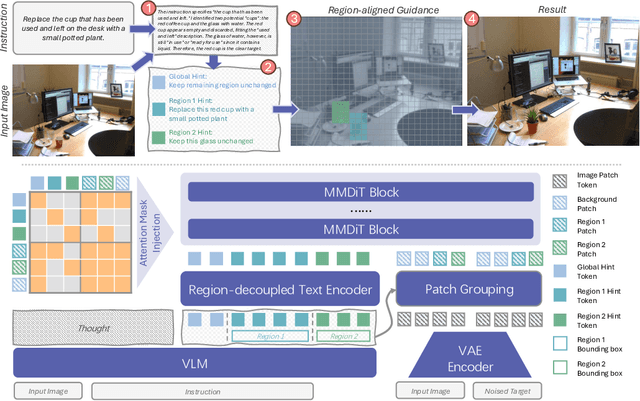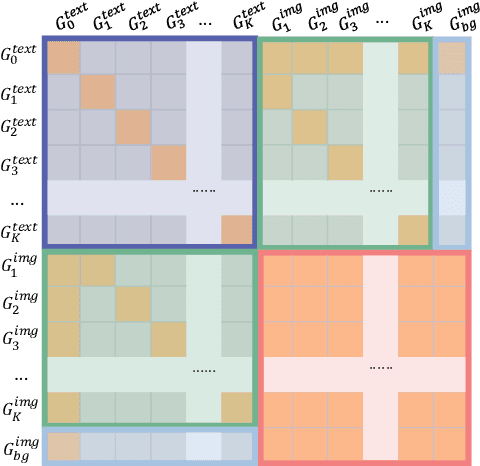Xiaohang Zhan
RePlan: Reasoning-guided Region Planning for Complex Instruction-based Image Editing
Dec 18, 2025



Abstract:Instruction-based image editing enables natural-language control over visual modifications, yet existing models falter under Instruction-Visual Complexity (IV-Complexity), where intricate instructions meet cluttered or ambiguous scenes. We introduce RePlan (Region-aligned Planning), a plan-then-execute framework that couples a vision-language planner with a diffusion editor. The planner decomposes instructions via step-by-step reasoning and explicitly grounds them to target regions; the editor then applies changes using a training-free attention-region injection mechanism, enabling precise, parallel multi-region edits without iterative inpainting. To strengthen planning, we apply GRPO-based reinforcement learning using 1K instruction-only examples, yielding substantial gains in reasoning fidelity and format reliability. We further present IV-Edit, a benchmark focused on fine-grained grounding and knowledge-intensive edits. Across IV-Complex settings, RePlan consistently outperforms strong baselines trained on far larger datasets, improving regional precision and overall fidelity. Our project page: https://replan-iv-edit.github.io
UniSER: A Foundation Model for Unified Soft Effects Removal
Nov 18, 2025Abstract:Digital images are often degraded by soft effects such as lens flare, haze, shadows, and reflections, which reduce aesthetics even though the underlying pixels remain partially visible. The prevailing works address these degradations in isolation, developing highly specialized, specialist models that lack scalability and fail to exploit the shared underlying essences of these restoration problems. While specialist models are limited, recent large-scale pretrained generalist models offer powerful, text-driven image editing capabilities. while recent general-purpose systems (e.g., GPT-4o, Flux Kontext, Nano Banana) require detailed prompts and often fail to achieve robust removal on these fine-grained tasks or preserve identity of the scene. Leveraging the common essence of soft effects, i.e., semi-transparent occlusions, we introduce a foundational versatile model UniSER, capable of addressing diverse degradations caused by soft effects within a single framework. Our methodology centers on curating a massive 3.8M-pair dataset to ensure robustness and generalization, which includes novel, physically-plausible data to fill critical gaps in public benchmarks, and a tailored training pipeline that fine-tunes a Diffusion Transformer to learn robust restoration priors from this diverse data, integrating fine-grained mask and strength controls. This synergistic approach allows UniSER to significantly outperform both specialist and generalist models, achieving robust, high-fidelity restoration in the wild.
Social Agent: Mastering Dyadic Nonverbal Behavior Generation via Conversational LLM Agents
Oct 06, 2025Abstract:We present Social Agent, a novel framework for synthesizing realistic and contextually appropriate co-speech nonverbal behaviors in dyadic conversations. In this framework, we develop an agentic system driven by a Large Language Model (LLM) to direct the conversation flow and determine appropriate interactive behaviors for both participants. Additionally, we propose a novel dual-person gesture generation model based on an auto-regressive diffusion model, which synthesizes coordinated motions from speech signals. The output of the agentic system is translated into high-level guidance for the gesture generator, resulting in realistic movement at both the behavioral and motion levels. Furthermore, the agentic system periodically examines the movements of interlocutors and infers their intentions, forming a continuous feedback loop that enables dynamic and responsive interactions between the two participants. User studies and quantitative evaluations show that our model significantly improves the quality of dyadic interactions, producing natural, synchronized nonverbal behaviors.
LaRender: Training-Free Occlusion Control in Image Generation via Latent Rendering
Aug 11, 2025Abstract:We propose a novel training-free image generation algorithm that precisely controls the occlusion relationships between objects in an image. Existing image generation methods typically rely on prompts to influence occlusion, which often lack precision. While layout-to-image methods provide control over object locations, they fail to address occlusion relationships explicitly. Given a pre-trained image diffusion model, our method leverages volume rendering principles to "render" the scene in latent space, guided by occlusion relationships and the estimated transmittance of objects. This approach does not require retraining or fine-tuning the image diffusion model, yet it enables accurate occlusion control due to its physics-grounded foundation. In extensive experiments, our method significantly outperforms existing approaches in terms of occlusion accuracy. Furthermore, we demonstrate that by adjusting the opacities of objects or concepts during rendering, our method can achieve a variety of effects, such as altering the transparency of objects, the density of mass (e.g., forests), the concentration of particles (e.g., rain, fog), the intensity of light, and the strength of lens effects, etc.
Stable-SCore: A Stable Registration-based Framework for 3D Shape Correspondence
Mar 27, 2025



Abstract:Establishing character shape correspondence is a critical and fundamental task in computer vision and graphics, with diverse applications including re-topology, attribute transfer, and shape interpolation. Current dominant functional map methods, while effective in controlled scenarios, struggle in real situations with more complex challenges such as non-isometric shape discrepancies. In response, we revisit registration-for-correspondence methods and tap their potential for more stable shape correspondence estimation. To overcome their common issues including unstable deformations and the necessity for careful pre-alignment or high-quality initial 3D correspondences, we introduce Stable-SCore: A Stable Registration-based Framework for 3D Shape Correspondence. We first re-purpose a foundation model for 2D character correspondence that ensures reliable and stable 2D mappings. Crucially, we propose a novel Semantic Flow Guided Registration approach that leverages 2D correspondence to guide mesh deformations. Our framework significantly surpasses existing methods in challenging scenarios, and brings possibilities for a wide array of real applications, as demonstrated in our results.
Video-T1: Test-Time Scaling for Video Generation
Mar 24, 2025Abstract:With the scale capability of increasing training data, model size, and computational cost, video generation has achieved impressive results in digital creation, enabling users to express creativity across various domains. Recently, researchers in Large Language Models (LLMs) have expanded the scaling to test-time, which can significantly improve LLM performance by using more inference-time computation. Instead of scaling up video foundation models through expensive training costs, we explore the power of Test-Time Scaling (TTS) in video generation, aiming to answer the question: if a video generation model is allowed to use non-trivial amount of inference-time compute, how much can it improve generation quality given a challenging text prompt. In this work, we reinterpret the test-time scaling of video generation as a searching problem to sample better trajectories from Gaussian noise space to the target video distribution. Specifically, we build the search space with test-time verifiers to provide feedback and heuristic algorithms to guide searching process. Given a text prompt, we first explore an intuitive linear search strategy by increasing noise candidates at inference time. As full-step denoising all frames simultaneously requires heavy test-time computation costs, we further design a more efficient TTS method for video generation called Tree-of-Frames (ToF) that adaptively expands and prunes video branches in an autoregressive manner. Extensive experiments on text-conditioned video generation benchmarks demonstrate that increasing test-time compute consistently leads to significant improvements in the quality of videos. Project page: https://liuff19.github.io/Video-T1
DreamMapping: High-Fidelity Text-to-3D Generation via Variational Distribution Mapping
Sep 11, 2024



Abstract:Score Distillation Sampling (SDS) has emerged as a prevalent technique for text-to-3D generation, enabling 3D content creation by distilling view-dependent information from text-to-2D guidance. However, they frequently exhibit shortcomings such as over-saturated color and excess smoothness. In this paper, we conduct a thorough analysis of SDS and refine its formulation, finding that the core design is to model the distribution of rendered images. Following this insight, we introduce a novel strategy called Variational Distribution Mapping (VDM), which expedites the distribution modeling process by regarding the rendered images as instances of degradation from diffusion-based generation. This special design enables the efficient training of variational distribution by skipping the calculations of the Jacobians in the diffusion U-Net. We also introduce timestep-dependent Distribution Coefficient Annealing (DCA) to further improve distilling precision. Leveraging VDM and DCA, we use Gaussian Splatting as the 3D representation and build a text-to-3D generation framework. Extensive experiments and evaluations demonstrate the capability of VDM and DCA to generate high-fidelity and realistic assets with optimization efficiency.
Programmable Motion Generation for Open-Set Motion Control Tasks
May 29, 2024Abstract:Character animation in real-world scenarios necessitates a variety of constraints, such as trajectories, key-frames, interactions, etc. Existing methodologies typically treat single or a finite set of these constraint(s) as separate control tasks. They are often specialized, and the tasks they address are rarely extendable or customizable. We categorize these as solutions to the close-set motion control problem. In response to the complexity of practical motion control, we propose and attempt to solve the open-set motion control problem. This problem is characterized by an open and fully customizable set of motion control tasks. To address this, we introduce a new paradigm, programmable motion generation. In this paradigm, any given motion control task is broken down into a combination of atomic constraints. These constraints are then programmed into an error function that quantifies the degree to which a motion sequence adheres to them. We utilize a pre-trained motion generation model and optimize its latent code to minimize the error function of the generated motion. Consequently, the generated motion not only inherits the prior of the generative model but also satisfies the required constraints. Experiments show that we can generate high-quality motions when addressing a wide range of unseen tasks. These tasks encompass motion control by motion dynamics, geometric constraints, physical laws, interactions with scenes, objects or the character own body parts, etc. All of these are achieved in a unified approach, without the need for ad-hoc paired training data collection or specialized network designs. During the programming of novel tasks, we observed the emergence of new skills beyond those of the prior model. With the assistance of large language models, we also achieved automatic programming. We hope that this work will pave the way for the motion control of general AI agents.
HeadEvolver: Text to Head Avatars via Locally Learnable Mesh Deformation
Mar 14, 2024Abstract:We present HeadEvolver, a novel framework to generate stylized head avatars from text guidance. HeadEvolver uses locally learnable mesh deformation from a template head mesh, producing high-quality digital assets for detail-preserving editing and animation. To tackle the challenges of lacking fine-grained and semantic-aware local shape control in global deformation through Jacobians, we introduce a trainable parameter as a weighting factor for the Jacobian at each triangle to adaptively change local shapes while maintaining global correspondences and facial features. Moreover, to ensure the coherence of the resulting shape and appearance from different viewpoints, we use pretrained image diffusion models for differentiable rendering with regularization terms to refine the deformation under text guidance. Extensive experiments demonstrate that our method can generate diverse head avatars with an articulated mesh that can be edited seamlessly in 3D graphics software, facilitating downstream applications such as more efficient animation with inherited blend shapes and semantic consistency.
HumanGaussian: Text-Driven 3D Human Generation with Gaussian Splatting
Nov 28, 2023Abstract:Realistic 3D human generation from text prompts is a desirable yet challenging task. Existing methods optimize 3D representations like mesh or neural fields via score distillation sampling (SDS), which suffers from inadequate fine details or excessive training time. In this paper, we propose an efficient yet effective framework, HumanGaussian, that generates high-quality 3D humans with fine-grained geometry and realistic appearance. Our key insight is that 3D Gaussian Splatting is an efficient renderer with periodic Gaussian shrinkage or growing, where such adaptive density control can be naturally guided by intrinsic human structures. Specifically, 1) we first propose a Structure-Aware SDS that simultaneously optimizes human appearance and geometry. The multi-modal score function from both RGB and depth space is leveraged to distill the Gaussian densification and pruning process. 2) Moreover, we devise an Annealed Negative Prompt Guidance by decomposing SDS into a noisier generative score and a cleaner classifier score, which well addresses the over-saturation issue. The floating artifacts are further eliminated based on Gaussian size in a prune-only phase to enhance generation smoothness. Extensive experiments demonstrate the superior efficiency and competitive quality of our framework, rendering vivid 3D humans under diverse scenarios. Project Page: https://alvinliu0.github.io/projects/HumanGaussian
 Add to Chrome
Add to Chrome Add to Firefox
Add to Firefox Add to Edge
Add to Edge